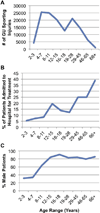Sports-related genitourinary injuries presenting to United States emergency departments
- PMID: 25530389
- PMCID: PMC4896133
- DOI: 10.1016/j.urology.2014.07.075
Sports-related genitourinary injuries presenting to United States emergency departments
Abstract
Objective: To describe epidemiologic features of sports-related genitourinary (GU) injuries and determine patient cohorts and particular sporting activities associated with increased GU injury risk.
Materials and methods: The National Electronic Injury Surveillance System, a data set validated to provide a probability sample of injury-related US emergency department (ED) presentations, was analyzed to characterize GU injuries between 2002 and 2010. A total of 13,851 observations were analyzed to derive national estimates.
Results: Between 2002 and 2010, an estimated 137,525 individuals (95% confidence interval, 104,490-170,620) presented to US EDs with GU injuries sustained during sporting activities. Nearly three-quarters of injuries occurred in the pediatric population. The most common product involved was a bicycle, representing approximately one-third of injuries in both adult and pediatric populations. Injuries related to team sports such as football, baseball or softball, basketball, and soccer were also common, particularly among boys where they represented a combined third of all injuries. Eighty-nine percent of all patients were evaluated and treated in the ED without inpatient admission. The large majority of injuries involved the external genitalia (60%), and significant injuries of paired GU organs (kidneys and testicles) requiring inpatient admission were rare (8.5%).
Conclusion: Sports-related GU injuries are most commonly sustained during the use of a bicycle. However, there are other associated activities with identifiable high-risk cohorts, products, and situations. Consumers, practitioners, and injury-prevention experts can use our epidemiologic data to prioritize and develop strategies aimed at the prevention and limitation of such injuries, particularly when counseling at-risk cohorts, such as those with solitary kidneys or testicles.
Copyright © 2015. Published by Elsevier Inc.
Figures
Comment in
-
Editorial comment.Urology. 2015 Jan;85(1):244-5. doi: 10.1016/j.urology.2014.07.076. Urology. 2015. PMID: 25530390 No abstract available.
-
Reply: To PMID 25530389.Urology. 2015 Jan;85(1):245. doi: 10.1016/j.urology.2014.07.077. Urology. 2015. PMID: 25530391 No abstract available.
References
Publication types
MeSH terms
Grants and funding
LinkOut - more resources
Full Text Sources
Other Literature Sources
Medical


